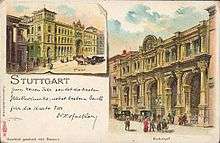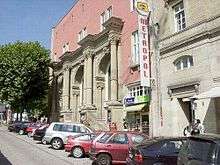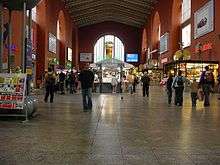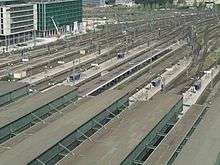Stuttgart Hauptbahnhof
Stuttgart Hauptbahnhof | |
|---|---|
| Terminal station | |
 Station building (2004) | |
| Location |
Stuttgart, Baden-Württemberg Germany |
| Coordinates | 48°47′02″N 9°10′54″E / 48.78389°N 9.18167°E |
| Platforms | 17 (1a and 1 to 16)[1][2] |
| Construction | |
| Architect | Paul Bonatz and Friedrich Eugen Scholer |
| Other information | |
| Station code | n/a |
| DS100 code | TS |
| Category | 1 |
| Website | www.bahnhof.de |
| History | |
| Opened | 1922 |
| Traffic | |
| Passengers | 220,000 daily[3] |
Stuttgart Hauptbahnhof is the primary railway station in the city of Stuttgart, the state capital of Baden-Württemberg, in southwestern Germany. It is the largest regional and long-distance railway station in Stuttgart, the main node of the Stuttgart S-Bahn network, and, together with the station at Charlottenplatz, it is the main node of the Stuttgart Stadtbahn.
Located at the northeastern end of the Königstraße, the main pedestrian zone of the city centre, the main line station is a terminus, whilst the subterranean S-Bahn and Stadtbahn stations are through-stations. The station is well known for its 12-storey tower with a large, rotating and illuminated Mercedes-Benz star insignia on top; the tower and station building are city landmarks.
Plans for the controversial Stuttgart 21 project to convert the main line terminus station into an underground through station include the demolition of the side wings of the building, together with the elimination of the platforms, tracks, and apron of the terminus station. The planned underground through station is configured at a 90 degree angle to the present station. Construction is scheduled from 2010 to 2019.
In November 2009, preservationists of the International Council on Monuments and Sites nominated the building for inclusion in UNESCO’s World Cultural Heritage list, an occasion that opponents of the Stuttgart 21 project picked to urge the city and Deutsche Bahn to stop the project which implies demolition of parts of the complex designed by Paul Bonatz.[4]
Building/structure details


The station building was constructed using reinforced concrete, which was then covered with roughly hewn shell limestone ashlar, sourced from the area around Crailsheim. The station tower is 56 metres (184 ft) high, with a rotating Mercedes-Benz star, measuring 5 metres (16 ft) in radius, on the visitor's terrace on the 9th level, right above the Bistro21. Also on the tower is a clock, whose radius measures 5.5 metres (18 ft). Inside the tower is the TurmForum Stuttgart 21, which provides information and media to do with the Stuttgart 21 project.
The front of the building features a quote by Georg Wilhelm Friedrich Hegel in the form of a lit inscription - the quote reads … daß diese Furcht zu irren schon der Irrtum selbst ist. - loosely translated as "… that this fear of making a mistake is a mistake itself." The inscription is a work by the artist Joseph Kosuth from the early 1990s.
Long-distance trains end their run in the above-ground terminus station at one of 17 tracks (1-16 and 1a), which is located on the second floor of the main hall, with the main entrance and service counters on the ground floor. Also in the main hall, near the south exit, a DB Lounge for first-class passengers and members of frequent-traveller programs, such as bahn.comfort, AIRail, or Miles & More, may be found. In the underground S-Bahn station, which is on the 3rd underground floor, all S-Bahn traffic, which is managed by the Verkehrs- und Tarifverbund Stuttgart (VVS), stops at one of two tracks (numbered 101 and 102).
Under the station forecourt, the seven lines of the Stadtbahn traverse the 2nd underground floor. A personnel passage on the 1st underground floor, which features many stores and boutiques, serves as the pedestrian connection between the Hauptbahnhof and the city center. A part of this 1st underground floor is taken up by an underground parking garage, and a multi-use shelter. In case of a civil emergency, a section of the garage would turn into a shelter with beds, separated from the rest of the garage by pressurized doors; the control room, kitchen, sanitation equipment, and water-and air conditioning for the shelter are located in the 2nd underground floor.
History
First and second Centralbahnhof


Until 1922, the central station was located on the Schlosstrasse (the precise location of the former station is on what is today called the Bolzstrasse), near the Schlossplatz. The first station building, a terminus station with 4 tracks, was built by Karl Etzel for the opening of the Württemberg Central Railway (Zentralbahn), with its two branches to Ludwigsburg and Esslingen. The building was not remarkable at the time, with the station hall, made of wood, covering the four tracks. On 26 September 1846, the first train, arriving from Canstatt, visited the station. By 1854, the first phase of railway construction in the Kingdom of Württemberg, with routes to Heilbronn, Bretten, Ulm, and Friedrichshafen, was completed.
Due to increasing railway traffic, the first building was replaced by new construction in the same spot in the 1860s. Between 1863 and 1867, the engineers Klein, Morlok, and Abel created this second station, with 8 tracks, featuring a building with grandiose arches in the Renaissance-style. By 1900, this station had already proven to be too small again. Parts of the façade of this building are today part of an event center and cinema, the Metropol.
The Hauptbahnhof of today

The present Hauptbahnhof was built between 1914 and 1928, only about 500 meters east of the former station, on the Arnulf-Klett-Platz.
In 1910, the Royal Württemberg State Railways (Königlich Württembergischen Staats-Eisenbahnen or K.W.St.E.) underwrote an architectural contest, which saw 70 participants. The competition was won by the architects Paul Bonatz and Friedrich Eugen Scholer with their plans for umbilicus sueviae - the Navel of Swabia. After undergoing numerous changes, including moving the station tower from the main façade to the wing at the Schlossgarten, construction began in 1914 on the Cannstatter Strasse. Due to the track routing to the old station, construction needed to be done in two phases, with the first phase going into service on 22 October 1922, and the second part being completed in 1928.
In addition to its great architectural quality, the new building was well incorporated into the other structures in the city center. The massive building deals with the steep terrain almost unnoticeably - there are nearly 5 meters from highest to lowest elevation between the tower and the so-called north exit. Bonatz put the tower directly on the axis of the Königstrasse as an optical point of aim, and another axis along the tower and the wing on the Schlossgarten continues on to the Neckar valley. The original plans called for a road leading directly to the building, but Bonatz eliminated this in favor of the Lautenschlagerstraße, as it is known today, which meets the Kleine Schalterhalle (small counter hall). Behind this hall are the tracks for the local commuter traffic, and in between this hall and the main building is the central exit, which is beneficial for the control of traffic flow. Underneath the tracks area, three tunnel at right angles to the tracks provide highly functional access points: The mail tunnel runs from the post office annex to the northwestern station area, a personnel tunnel eases the task of changing tracks, and a third tunnel is meant for the transit of express freight.
The construction has some highly regarded features. The façade is made of limestone, which was covered with bricks; on the inside, sandstone, tuff, and bricks form the walls. The roof structures are partially flat wood roofing, and partially constructed as reinforced concrete roofing. The use of exposed concrete on the pillars lends a modern flair to the main hall. The structure features conservative elements, shown in the monumentality and reserved decorations, as well as progressive elements, as shown by the flat roof structures, for example. The building is one of the most important architectural achievements in southern Germany.
On 15 May 1933, the electrification of all 17 tracks was completed. During World War II, the building was severely damaged on several occasions, even though the fake structure built to look like the Hauptbahnhof near Lauffen am Neckar successfully prevented further destruction. Reconstruction took several years after the end of the war. On 20 August 1987, the building was given the designation of a cultural monument of special significance.
S-Bahn, Stadtbahn and Stuttgart 21
Between 1971 and 1978, a tunnel was dug under the Hauptbahnhof for the Verbindungsbahn of the S-Bahn network of the middle Neckar area, and an underground station was constructed. This station features two tracks, with the platform in the middle, and was put into service on 1 October 1978.
The underground station for the U-Bahn and Strassenbahn, called Hauptbahnhof (Arnulf-Klett-Platz), went into operation on 9 April 1976. Today, there are seven lines of the Stadtbahn which use this station. The last remaining Strassenbahn line, number 15, was converted to the Stadtbahn service on 9 December 2007. The lower Strassenbahn platform is no longer used for regular service, but may sometimes see special or nostalgia trains.
The connected freight station, which featured a marshaling hump and rail brakes, was closed, due to both the reduction in freight traffic, and in preparation for the Stuttgart 21 project.
Current developments
Reconstruction for Stuttgart 21 and Protests
Construction on the new underground station as part of Stuttgart 21 was originally to be started in 2005 and completed in 2012; the revised schedule now envisions a start in 2010, and completion, including the new Wendlingen–Ulm high-speed railway, in 2019, at a total cost of 4.8 billion Euros.
As part of the Stuttgart 21 project, the two wings were demolished. Widespread resentment of the entire project to bring the train station underground is expressed by increasing mobilization of the Stuttgart citizenry. In particular the felling of some 260 huge and old trees has nurtured a resistance hitherto unknown in Stuttgart politics.
More than 18,000 people have registered as Parkschützer (Park Guardians); about a thousand have vowed to stay in the path of demolition crews while chaining themselves to the trees. The colourful resistance has led to nearly daily demonstrations and has raised the spectre of a political landslide during the forthcoming provincial elections.
The Stuttgart architect and Bonatz expert Matthias Roser initiated an international call for the preservation of the Hauptbahnhof, including the wings, and over 400 architects, building historians, monument conservators, art historians, and city planners, such as the Pritzger Prize recipient Richard Meier or David Chipperfield, have joined this effort. This group views the Bonatz-designed building as one of the most significant railway station structures of the 20th century in Germany and Europe as a whole, and are opposed to any structural changes.
On November 27, 2011, a referendum on the project "Stuttgart 21" resulted in 58.8% voted in favor of the project, 41.2% voted against it.[5]
Operations
Routes
The Hauptbahnhof is a traffic node for these routes:
- Mannheim–Stuttgart high-speed railway to Mannheim
- Württemberg Western Railway (Westbahn) to Mühlacker – Karlsruhe/Heidelberg
- Franconia Railway (Frankenbahn) to Bietigheim-Bissingen – Heilbronn – Würzburg
- Black Forest Railway (Schwarzwaldbahn) to Leonberg – Weil der Stadt
- Murr Railway (Murrbahn) to Backnang – Nuremberg
- Rems Railway (Remsbahn) to Schorndorf – Aalen
- Fils Valley Railway (Filstalbahn) to Plochingen – Göppingen – Ulm
- Neckar-Alb railway (Neckar-Alb-Bahn) to Plochingen – Tübingen
- Gäubahn to Herrenberg – Rottweil/Freudenstadt - Singen
Long-distance connections
The most significant long-distance connections available at the Stuttgart Hauptbahnhof are listed here:
| Connection | Route | Frequency |
|---|---|---|
| | Berlin – Frankfurt (Main) – Stuttgart – Munich– (Innsbruck) | every 2 hours |
| | Kiel/Hamburg – Hannover – Göttingen – Kassel – Fulda – Frankfurt (Main) Hbf – Frankfurt (Main) Flughafen – Mannheim – Stuttgart | every 2 hours |
| | Dortmund – Essen – Düsseldorf – Köln – Siegburg/Bonn – Frankfurt (Main) Flughafen – Mannheim – Stuttgart – Ulm – Augsburg – Munich | every 2 hours |
| | Paris – Straßburg – Karlsruhe – Stuttgart | every 2 hours |
| | (Frankfurt (Main)) – Stuttgart – Horb – Rottweil – Tuttlingen – Singen (Htw.) – Schaffhausen – Bülach – Zürich | every 2 hours |
| IC 30 | Westerland (Sylt)/Ostseebad Binz – Hamburg – Bremen – Münster (Westf.) – Dortmund – Essen – Köln – Bonn – Koblenz – Mainz – Mannheim – Heidelberg – Vaihingen (Enz) – Stuttgart | every 2 hours |
| IC 32 | Berlin – Hannover – Bielefeld – Dortmund – Köln – Koblenz – Mainz – Mannheim – Heidelberg – Vaihingen (Enz) – Stuttgart – Ulm – Friedrichshafen – Lindau – Bregenz – Innsbruck | 1 train |
| IC 35 | Norddeich – Emden – Münster (Westf.) – Duisburg – Köln – Bonn – Koblenz – Mainz – Mannheim – Heidelberg – Stuttgart | 1 train |
| IC 55 | Leipzig – Magdeburg – Braunschweig – Hannover – Dortmund – Köln – Bonn – Koblenz – Mainz – Mannheim – Heidelberg – Stuttgart – Göppingen – Ulm – Memmingen – Kempten – Oberstdorf | 1 train |
| IC 60 | Karlsruhe – Stuttgart – Göppingen – Ulm – Günzburg – Augsburg – Munich | every 2 hours |
| IC 61 | Karlsruhe – Pforzheim – Stuttgart – Aalen – Crailsheim – Ansbach – Nürnberg | every 2 hours |
| IC 62 | Saarbrücken/Frankfurt (Main) – Heidelberg – Stuttgart – Ulm – Günzburg – Augsburg – Munich– Rosenheim – Salzburg – Klagenfurt/Graz/Linz | every 2 hours |
| Preceding station | Deutsche Bahn | Following station | ||
|---|---|---|---|---|
towards Berlin Ostbahnhof | ICE 11 | towards Munich Hbf |
||
towards Hamburg-Altona | ICE 22 | Terminus | ||
towards Hamburg-Altona |
||||
towards Hamburg-Altona | ICE 42 | towards Munich Hbf |
||
towards Cologne Hbf | ICE 45 | Terminus | ||
towards Paris Est | ICE/TGV 83 | towards Munich Hbf |
||
towards Frankfurt (Main) Hbf | ICE 87 4 trains | Horb towards Zurich Hbf |
||
toward Frankfurt Hbf | Railjet | toward Budapest Keleti |
||
| IC/EC 30 | Terminus | |||
towards Berlin Südkreuz | IC/EC 32 1 train | towards Innsbruck Hbf |
||
towards Emden Außenhafen or Norddeich Mole | IC/EC 35 1 train | Terminus | ||
towards Dresden Hbf | IC 55 1 train | towards Oberstdorf |
||
towards Strasbourg | IC 60 | towards Salzburg Hbf |
||
towards Karlsruhe Hbf | IC 61 | towards Passau Hbf |
||
towards Frankfurt (Main) Hbf | IC/EC 62 | towards Salzburg Hbf |
||
towards Saarbrücken Hbf |
Regional connections
| Route | Frequency | |
|---|---|---|
| IRE R1 | Stuttgart - Plochingen - Göppingen - Geißlingen (Steige) - Ulm - Biberach - Friedrichshafen - Lindau | every 2 hours |
| IRE R5 | Stuttgart - Vaihingen (Enz) - Mühlacker - Pforzheim - Karlsruhe | every 2 hours (plus additional trains Stuttgart - Vaihingen) |
| IRE R8 | Stuttgart - Reutlingen - Tübingen - Hechingen - Albstadt - Sigmaringen - Aulendorf | every 2 hours (occasional splitting of trains in Tübingen to Horb) |
| RE R1 | Stuttgart - Esslingen (N) - Plochingen - Göppingen - Geislingen (Steige) - Ulm | every hour |
| RE R2 | Stuttgart - Waiblingen - Schorndorf - Schwäbisch Gmünd - Aalen | every hour (from noon until evening every 30 minutes) |
| RE R3 | Stuttgart - Waiblingen - Backnang - Schwäbisch Hall-Hessental - Crailsheim - Ansbach - Nürnberg | every 2 hours (Mon-Fri between Stuttgart and Schwäb. Hall every hour, at rush hour every 30 minutes, Sat and Sun Stuttgart-Schwäb. Hall requires change of trains in Backnang) |
| RE R4 | Stuttgart - Ludwigsburg - Bietigheim-Bissingen - Heilbronn - Bad Friedrichshall - Osterburken - Würzburg | every 2 hours |
| RE R5 | Stuttgart - Ludwigsburg - Bietigheim-Bissingen - Vaihingen (Enz) - Mühlacker - Pforzheim - Karlsruhe | every 2 hours |
| RE R5 | Stuttgart - Ludwigsburg - Bietigheim-Bissingen - Vaihingen (Enz) - Mühlacker - Bretten - Bruchsal - Heidelberg | every 2 hours |
| RE R7 | Stuttgart - Böblingen - Herrenberg - Eutingen im Gäu - Horb - Rottweil - Tuttlingen - Singen (Hohentwiehl) | every 2 hours |
| RE R7 | Stuttgart - Böblingen - Herrenberg - Eutingen im Gäu - Horb - Rottweil | every 2 hours (shares train between Stuttgart and Eutingen with RegionalExpress train Stuttgart–Freudenstadt) |
| RE R7 | Stuttgart - Böblingen - Herrenberg - Eutingen im Gäu - Freudenstadt | every 2 hours (shares train between Stuttgart and Eutingen with RegionalExpress train Stuttgart–Rottweil) |
| RE R8 | Stuttgart - Esslingen (N) - Plochingen - Nürtingen - Metzingen - Reutlingen - Tübingen | every hour (from noon until evening every 30 minutes) |
| RB R1 | Stuttgart - Esslingen - Plochingen - Göppingen - Geislingen (Steige) | every 2 hours |
| RB R1 | Stuttgart - Ludwigsburg - Bietigheim-Bissingen - Heilbronn - Bad Friedrichshall - Mosbach-Neckarelz | every hour (between Stuttgart and Heilbronn every 30 minutes) |
In most cases, these connection start or end in Stuttgart. This means that for most connections that go through Stuttgart Hauptbahnhof, a change of trains is necessary. As part of the Stuttgart 21 project, with Stuttgart Hbf becoming a through-station, most regional connections would no longer require the change of trains.
A frequent topic of discussion is the reactivation of the section Weil der Stadt – Calw on the Schwarzwaldbahn (Württemberg), which would mean the addition of a Regionalbahn or Regional-Express train with the route Stuttgart – Leonberg – Weil der Stadt – Calw.
S-Bahn connections
| Line No. | Route |
|---|---|
| S 1 | Kirchheim unter Teck – Plochingen – Esslingen – Neckarpark – Bad Cannstatt – Hauptbahnhof – Schwabstraße – Vaihingen – Rohr – Böblingen – Herrenberg (additional trains on work days between Esslingen and Schwabstraße or Böblingen.) |
| S 2 | Schorndorf – Weinstadt – Waiblingen – Bad Cannstatt – Hauptbahnhof – Schwabstraße – Vaihingen – Rohr – Flughafen/Messe – Filderstadt (additional trains on work days between Schorndorf and Vaihingen.) |
| S 3 | Backnang – Winnenden – Waiblingen – Bad Cannstatt – Hauptbahnhof – Vaihingen – Rohr – Flughafen/Messe (due to the opening of the new exhibition center, trains run to the airport on weekends; late evening traffic only goes to Vaihingen; additional trains on work days between Backnang and Vaihingen). |
| S 4 | Backnang – Marbach – Ludwigsburg – Zuffenhausen – Hauptbahnhof – Schwabstraße |
| S 5 | Schwabstraße – Hauptbahnhof – Zuffenhausen – Ludwigsburg – Bietigheim |
| S 6 | Schwabstraße – Hauptbahnhof – Zuffenhausen – Leonberg – Weil der Stadt |
| S 60 | Schwabstraße – Hauptbahnhof – Zuffenhausen – Leonberg – Renningen – Magstadt – Maichingen – Sindelfingen – Böblingen |
The abbreviation for the Hauptbahnhof S-Bahn station underground is TST.
Freight traffic



In addition to the passenger station, there used to be a closed and already demolished freight station and small shunting station, which featured a marshaling hump with rail brakes.
Stadtbahn
Under the Arnulf-Klett-Platz (the station forecourt), the largest and most important node of the Stadtbahn features these routes:
| Line No. | Route |
|---|---|
| U5 | Killesberg – Hauptbahnhof – Degerloch – Möhringen – Leinfelden |
| U6 | Gerlingen – Weilimdorf – Feuerbach – Hauptbahnhof – Degerloch – Möhringen – Fasanenhof |
| U7 | Mönchfeld – Zuffenhausen – Hauptbahnhof – Ruhbank/Fernsehturm – Heumaden – Ostfildern-Nellingen |
| U9 | Hedelfingen – Raitelsberg – Hauptbahnhof – Vogelsang (– Botnang) During summer break and outside of rush hours only between Hedelfingen and Vogelsang. |
| U12 | Killesberg – Hauptbahnhof – Degerloch – Möhringen – (Vaihingen) Outside of rush hours only between Killesberg and Möhringen. |
| U14 | Remseck-Neckargröningen – Münster – Hauptbahnhof – Rotebühlplatz – Heslach Vogelrain |
| U15 | Stammheim - Zuffenhausen – Nordbahnhof – Hauptbahnhof – Eugensplatz – Ruhbank/Fernsehturm (– Heumaden) |
In addition, in case of events at the NeckarPark and Cannstatter Wasen
| Line No. | Route |
|---|---|
| U11 | Hauptbahnhof – Rotebühlplatz – Mineralbäder – Cannstatter Wasen – Neckarpark (Stadion) |
Noteworthy
The Hauptbahnhof has been assigned the IATA code ZWS, because the station is used by Lufthansa in the AIRail concept. Passengers may travel in ICE trains, which are also assigned flight numbers, to Frankfurt Airport in Frankfurt am Main, instead of using a short-distance flight. For this reason, Lufthansa has a check-in counter near the entrance from the Arnulf-Klett-Platz. Passengers were able to both check and receive their baggage at this counter until 2007; since then, only check-in is possible.
See also
Notes
- ↑ "OpenRailwayMap" (Map). Map of Stuttgart Hauptbahnhof. Cartography by OpenStreetMap. OpenRailwayMap. 28 September 2014. Retrieved 2014-10-19.
- ↑ "Lageplan Hauptbahnhof Stuttgart" (PDF) (orientation map) (in German). Deutsche Bahn AG. 2014. Retrieved 2014-10-19.
- ↑ Stuttgart Hauptbahnhof: 140 Kilometer Gleise auf 82 Hektar Grund. Information found at bahnhof.de, accessed on 13 December 2008
- ↑ "Bonatzbau soll Weltkulturerbe werden". Stuttgarter Nachrichten (in German). 11 November 2009. Retrieved 21 February 2012.
- ↑ S21-Gegner scheitern bei Referendum (German) (Nov 27, 2011)
Further reading
- Dostal, Michael; Estler, Thomas (2012). Stuttgart Hauptbahnhof: Geschichte eines Bahnhofs [Stuttgart Hauptbahnhof: History of a Station] (in German). München: GeraMond Verlag. ISBN 978-3-86245-141-8.
- Matthias Roser: Der Stuttgarter Hauptbahnhof - Vom Kulturdenkmal zum Abrisskandidaten ? 1. Auflage, 2008, Schmetterling Verlag, Stuttgart, 151 Seiten, ISBN 3-89657-133-8
- Matthias Roser: Der Stuttgarter Hauptbahnhof – ein vergessenes Meisterwerk der Architektur. 1. Auflage, 1987, Silberburg-Verlag Stuttgart, 60 Seiten, ISBN 3-925344-13-6
- Kurt Seidel: 65 Jahre Stuttgarter Hauptbahnhof 1922 bis 1987. Herausgegeben von der Bundesbahndirektion Stuttgart, 1987, 160 Seiten
- Egon Hopfenzitz und Klaus Fischer: Chronik Stuttgarter Hauptbahnhof 1846 bis 1998. Herausgegeben von der DB Station&Service AG, Stuttgart, 1999, 381 Seiten
- Werner Willhaus (Herausgeber): Verkehrsknoten Stuttgart. EK-Verlag, Freiburg 2006, ISBN 978-3-88255-251-5
External links
 Media related to Stuttgart Hauptbahnhof at Wikimedia Commons
Media related to Stuttgart Hauptbahnhof at Wikimedia Commons
Coordinates: 48°47′02″N 9°10′54″E / 48.78389°N 9.18167°E